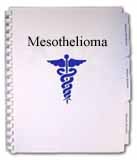|
Mesothelioma and Lung Cancer News - Return to Menu
Workers Exposed To Libby Vermiculite Ore Have High Rate Of Chest Wall Abnormalities
SAN DIEGO -- More than one-quarter of tested workers at an Ohio manufacturing plant historically exposed to asbestos-containing vermiculite ore exhibited signs of scarring of the chest wall lining, a study by researchers from the University of Cincinnati has found.
Researchers examined recent chest X-rays of 236 people who worked at a plant in Marysville, Ohio, that until 1980 used vermiculite ore mined in Libby, Mont., that contained asbestos fibers.
Of the 236 workers tested, 62 (26.3 percent) showed pleural plaques, or scarring of the chest wall lining. The occurrence was as high as 44.1 percent in workers with the largest and heaviest exposure to the vermiculite ore. The percentage of workers with pleural plaques was 5.1 percent in those with the lowest levels of exposure.
Pleural plaques are usually considered markers of previous exposure to asbestos fibers. Because of the previous exposure to asbestos, there is a potential increased risk for other asbestos-related lung changes, including scar tissue within the lungs and certain types of cancer such as mesothelioma.
Preliminary results of the study were presented in San Diego May 24, 2005, at the annual International Conference of the American Thoracic Society.
"Our study shows that cumulative exposure to vermiculite from Libby is associated with a significant increase in pleural changes," said study leader James Lockey, MD, professor of occupational and pulmonary medicine at the University of Cincinnati College of Medicine.
"There is clearly a relationship with increasing exposure, but the pleural changes also were seen in the low-exposed workers," said co-author Amy Rohs, MD, a fellow in occupational and pulmonary medicine at University of Cincinnati.
About 0.2 percent of the general population with minimal history of exposure to respiratory hazards shows signs of pleural plaques, Dr. Lockey noted. "I was surprised at the significant increase in overall pleural changes in this working population from 2 percent in 1980 to 26 percent, based on these preliminary results," he added.
"The public health implications of these preliminary findings are important in view of the national distribution of the Libby vermiculite ore," the authors concluded.
Until 1990, more than 200 sites around the country received shipments of vermiculite from the Libby mine.
Vermiculite is a group of minerals with a flaky, mica-like structure. Vermiculite ore from Libby has been shown to contain high levels of asbestos, which could have become airborne and inhaled when used in manufacturing. Vermiculite is widely used in a variety of applications, including insulation, packing materials, construction materials and gardening products. The Libby mine closed in 1990 and vermiculite ore used now comes from other sources and is not known to contain asbestos.
The X-rays were taken during the past two years, and each was reviewed independently by three board-certified radiologists. Spirometry tests, which measure lung function, and health histories also were taken. Although these were not assessed for this study, they will be reported later when the complete study findings are reviewed and published.
The workers were among a group of 513 employees at the Ohio plant exposed to vermiculite and who took part in a 1980 study. Of these 513 workers, 433 (84 percent) are currently alive. That original study, published by Dr. Lockey in the June 1984 issue of American Review of Respiratory Disease, initially showed that exposure to vermiculite containing asbestos fibers could cause pleural plaques.
###
The current study was funded by the Agency for Toxic Substances and Disease Registry (ATSDR) of the Centers for Disease Control and Prevention (CDC). Additional information on ATSDR and Libby asbestos can be found at https://www.atsdr.cdc.gov/naer/index.html.
Co-authors of the study were Kari Dunning, PhD, Jerome Wiot, MD, Ralph Shipley, MD, Chris Meyer, MD, Tim Hilbert and Rakesh Shukla, PhD, of the University of Cincinnati and Vikas Kapil, DO, of the CDC/ATSDR.
Source: University of Cincinnati
Date: 2005-07-10
Asbestos-inspection rules relaxed for some demolitions
By MIKE DUNNE
Advocate staff writer
Mar 11, 2006 - Rules requiring pre-demolition inspections for asbestos are being relaxed for some hurricane-damaged homes, though the debris will have to be handled as if it contains the harmful material.
Normally, only buildings that are “structurally unsound and in danger of imminent collapse” are freed from the asbestos-inspection requirement.
But the U.S. Environmental Protection Agency recently expanded that definition to include homes that have been washed off their foundations or are so flood-damaged that they must be torn down.
EPA public affairs spokesman David Ryan in Washington, D.C., said the public’s health will be protected because the demolitions will be conducted as if there is asbestos.
“Material must be disposed of in landfills that meet the federal asbestos requirements,” Ryan added.
Asbestos produces microscopic particles linked to life-threatening diseases, including lung cancer.
With an estimated 270,000 damaged homes, the state is looking for a way to speed up the demolition process, which led to the EPA’s decision, state environmental officials said.
The debris from uninspected houses will still have to be wetted down as if it does contain asbestos and disposed of in compliance with National Emission Standards for Hazardous Air Pollutants. That means the work must be done by trained personnel using methods designed to contain asbestos emissions.
Not all of the state’s construction and demolition landfills meet NESHAP requirements, DEQ Assistant Secretary Chuck Carr Brown said.
The state is working with some to help them meet those rules, he said.
|

































